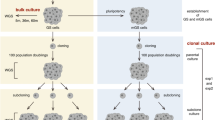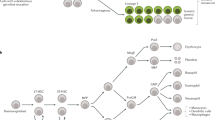Abstract
Human artificial chromosomes (HACs) have several advantages as gene therapy vectors, including stable episomal maintenance that avoids insertional mutations and the ability to carry large gene inserts including regulatory elements. Multipotent germline stem (mGS) cells have a great potential for gene therapy because they can be generated from an individual's testes, and when reintroduced can contribute to the specialized function of any tissue. As a proof of concept, we herein report the functional restoration of a genetic deficiency in mouse p53−/− mGS cells, using a HAC with a genomic human p53 gene introduced via microcell-mediated chromosome transfer. The p53 phenotypes of gene regulation and radiation sensitivity were complemented by introducing the p53-HAC and the cells differentiated into several different tissue types in vivo and in vitro. Therefore, the combination of using mGS cells with HACs provides a new tool for gene and cell therapies. The next step is to demonstrate functional restoration using animal models for future gene therapy.
This is a preview of subscription content, access via your institution
Access options
Subscribe to this journal
Receive 12 print issues and online access
$259.00 per year
only $21.58 per issue
Buy this article
- Purchase on Springer Link
- Instant access to full article PDF
Prices may be subject to local taxes which are calculated during checkout




Similar content being viewed by others
References
Rideout III WM, Hochedlinger K, Kyba M, Daley GQ, Jaenisch R . Correction of a genetic defect by nuclear transplantation and combined cell and gene therapy. Cell 2002; 109: 17–27.
Kuroiwa Y, Kasinathan P, Matsushita H, Sathiyaselan J, Sullivan EJ, Kakitani M et al. Sequential targeting of the genes encoding immunoglobulin-mu and prion protein in cattle. Nat Genet 2004; 36: 775–780.
Cossu G, Sampaolesi M . New therapies for muscular dystrophy: cautious optimism. Trends Mol Med 2004; 10: 516–520.
Odom GL, Gregorevic P, Chamberlain JS . Viral-mediated gene therapy for the muscular dystrophies: successes, limitations and recent advances. Biochim Biophys Acta 2007; 1772: 243–262.
Pagani F, Buratti E, Stuani C, Bendix R, Dork T, Baralle FE . A new type of mutation causes a splicing defect in ATM. Nat Genet 2002; 30: 426–429.
O'Connor TP, Crystal RG . Genetic medicines: treatment strategies for hereditary disorders. Nat Rev Genet 2006; 7: 261–276.
Hacein-Bey-Abina S, Von Kalle C, Schmidt M, McCormack MP, Wulffraat N, Leboulch P et al. LMO2-associated clonal T cell proliferation in two patients after gene therapy for SCID-X1. Science 2003; 302: 415–419.
Kuroiwa Y, Tomizuka K, Shinohara T, Kazuki Y, Yoshida H, Ohguma A et al. Manipulation of human minichromosomes to carry greater than megabase-sized chromosome inserts. Nat Biotechnol 2000; 18: 1086–1090.
Katoh M, Ayabe F, Norikane S, Okada T, Masumoto H, Horike S et al. Construction of a novel human artificial chromosome vector for gene delivery. Biochem Biophys Res Commun 2004; 321: 280–290.
Basu J, Willard HF . Artificial and engineered chromosomes: non-integrating vectors for gene therapy. Trends Mol Med 2005; 11: 251–258.
Dennis C . Cloning: mining the secrets of the egg. Nature 2006; 439: 652–655.
Hall VJ, Stojkovic P, Stojkovic M . Using therapeutic cloning to fight human disease: a conundrum or reality? Stem Cells 2006; 24: 1628–1637.
Kanatsu-Shinohara M, Inoue K, Lee J, Yoshimoto M, Ogonuki N, Miki H et al. Generation of pluripotent stem cells from neonatal mouse testis. Cell 2004; 119: 1001–1012.
Frengen E, Zhao B, Howe S, Weichenhan D, Osoegawa K, Gjernes E et al. Modular bacterial artificial chromosome vectors for transfer of large inserts into mammalian cells. Genomics 2000; 68: 118–126.
Horikawa I, Okamoto A, Yokota J, Oshimura M . Genetic heterogeneity of chromosome 11 associated with tumorigenicity in HeLa D98-OR cells. Cancer Genet Cytogenet 1995; 85: 97–100.
Ikeno M, Masumoto H, Okazaki T . Distribution of CENP-B boxes reflected in CREST centromere antigenic sites on long-range alpha-satellite DNA arrays of human chromosome 21. Hum Mol Genet 1994; 3: 1245–1257.
Kawasaki H, Mizuseki K, Nishikawa S, Kaneko S, Kuwana Y, Nakanishi S et al. Induction of midbrain dopaminergic neurons from ES cells by stromal cell-derived inducing activity. Neuron 2000; 28: 31–40.
Bourdon JC, Fernandes K, Murray-Zmijewski F, Liu G, Diot A, Xirodimas DP et al. p53 isoforms can regulate p53 transcriptional activity. Genes Dev 2005; 19: 2122–2137.
Tomizuka K, Yoshida H, Uejima H, Kugoh H, Sato K, Ohguma A et al. Functional expression and germline transmission of a human chromosome fragment in chimaeric mice. Nat Genet 1997; 16: 133–143.
Lin T, Chao C, Saito S, Mazur SJ, Murphy ME, Appella E et al. p53 induces differentiation of mouse embryonic stem cells by suppressing Nanog expression. Nat Cell Biol 2005; 7: 165–171.
Voet T, Schoenmakers E, Carpentier S, Labaere C, Marynen P . Controlled transgene dosage and PAC-mediated transgenesis in mice using a chromosomal vector. Genomics 2003; 82: 596–605.
Mejia JE, Willmott A, Levy E, Earnshaw WC, Larin Z . Functional complementation of a genetic deficiency with human artificial chromosomes. Am J Hum Genet 2001; 69: 315–326.
Ayabe F, Katoh M, Inoue T, Kouprina N, Larionov V, Oshimura M . A novel expression system for genomic DNA loci using a human artificial chromosome vector with transformation-associated recombination cloning. J Hum Genet 2005; 50: 592–599.
Kouprina N, Larionov V . TAR cloning: insights into gene function, long-range haplotypes and genome structure and evolution. Nat Rev Genet 2006; 7: 805–812.
Copeland NG, Jenkins NA, Court DL . Recombineering: a powerful new tool for mouse functional genomics. Nat Rev Genet 2001; 2: 769–779.
Wallace HA, Marques-Kranc F, Richardson M, Luna-Crespo F, Sharpe JA, Hughes J et al. Manipulating the mouse genome to engineer precise functional syntenic replacements with human sequence. Cell 2007; 128: 197–209.
Guan K, Nayernia K, Maier LS, Wagner S, Dressel R, Lee JH et al. Pluripotency of spermatogonial stem cells from adult mouse testis. Nature 2006; 440: 1199–1203.
Takahashi K, Yamanaka S . Induction of pluripotent stem cells from mouse embryonic and adult fibroblast cultures by defined factors. Cell 2006; 126: 663–676.
Suda T, Katoh M, Hiratsuka M, Takiguchi M, Kazuki Y, Inoue T et al. Heat-regulated production and secretion of insulin from a human artificial chromosome vector. Biochem Biophys Res Commun 2006; 340: 1053–1061.
Boley SE, Wong VA, French JE, Recio L . p53 heterozygosity alters the mRNA expression of p53 target genes in the bone marrow in response to inhaled benzene. Toxicol Sci 2002; 66: 209–215.
Otsuki A, Tahimic CG, Tomimatsu N, Katoh M, Chen DJ, Kurimasa A et al. Construction of a novel expression system on a human artificial chromosome. Biochem Biophys Res Commun 2005; 329: 1018–1025.
Trowell HE, Nagy A, Vissel B, Choo KH . Long-range analyses of the centromeric regions of human chromosomes 13, 14 and 21: identification of a narrow domain containing two key centromeric DNA elements. Hum Mol Genet 1993; 2: 1639–1649.
Acknowledgements
We thank K Sato for providing the human p53 cDNA; K Hanaoka, S Tsuji, C Okita, H Yamada, Y Iida and J Nakamura for technical assistance and K Tomizuka, A Kurimasa H Kugoh, T Inoue and M Hiratsuka for valuable discussions. This study was supported in part by a Health and Labor Science Research Grant for Research on the Human Genome, Tissue Engineering from the Ministry of Health, Labour and Welfare, Japan (MO), and the 21st Century COE program from the Ministry of Education, Culture, Sports, Science and Technology of Japan (MO).
Author information
Authors and Affiliations
Corresponding author
Additional information
Supplementary Information accompanies the paper on Gene Therapy website (http://www.nature.com/gt)
Supplementary information
Rights and permissions
About this article
Cite this article
Kazuki, Y., Hoshiya, H., Kai, Y. et al. Correction of a genetic defect in multipotent germline stem cells using a human artificial chromosome. Gene Ther 15, 617–624 (2008). https://doi.org/10.1038/sj.gt.3303091
Received:
Revised:
Accepted:
Published:
Issue Date:
DOI: https://doi.org/10.1038/sj.gt.3303091
Keywords
This article is cited by
-
De novo formed satellite DNA-based mammalian artificial chromosomes and their possible applications
Chromosome Research (2015)
-
Mouse embryonic stem cells with a multi-integrase mouse artificial chromosome for transchromosomic mouse generation
Transgenic Research (2015)
-
A pathway from chromosome transfer to engineering resulting in human and mouse artificial chromosomes for a variety of applications to bio-medical challenges
Chromosome Research (2015)
-
A novel transchromosomic system: stable maintenance of an engineered Mb-sized human genomic fragment translocated to a mouse chromosome terminal region
Transgenic Research (2014)
-
A new generation of human artificial chromosomes for functional genomics and gene therapy
Cellular and Molecular Life Sciences (2013)



